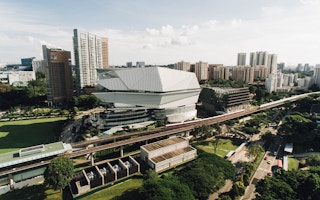Easy access to high quality and efficient transportation infrastructure already makes Singapore one of greatest cities in the world to live and work. But the desire to attract the best talent and businesses from around the world has prompted Singapore to embrace a new challenge to become “car-lite” and boost public transport use.
To continue reading, subscribe to Eco‑Business.
There's something for everyone. We offer a range of subscription plans.
- Access our stories and receive our Insights Weekly newsletter with the free EB Member plan.
- Unlock unlimited access to our content and archive with EB Circle.
- Publish your content with EB Premium.
Singapore currently boasts a public transport mode share of 66 per cent. The government’s new target is to achieve a public transport mode share of 75 per cent during peak hours by 2030, and it is investing in improvements to public transport infrastructure.
However, despite substantial effort over many years, Singapore is still seen as being too car centric in comparison to cities like Hong Kong, which has a public transport mode share of 88 per cent.
How can Singapore hit its existing targets and accelerate the change towards a new “car-lite” future? Digital technology could be a big part of the solution.
New technology trends
In a car-lite future, individual car ownership will disappear to make way for public transport and car use as a service. One technology that can help achieve this, as well as revolutionise several other aspects of life, is Artificial Intelligence (AI).
Autonomous vehicles (AV) are now one of the most talked about products to be driven by AI. Technology giants Google, Tesla and Uber are already testing their fully automated vehicles, and smaller companies like nuTonomy and Delphi are now conducting their respective pilot tests in Singapore. Singapore leaders predict that within 10 to 15 years the technology will be mature enough to be deployed widely.
The use of AI technology in transport will be dependent on “big data”, a concept which refers to the use of computing technology to process huge amounts of data about things like consumer behaviour, mobility trends, and more.
These technologies will not only directly change our lives by making driverless vehicles a reality, but will also increasingly trigger new business models. For example, people can also harness big data to create solutions for the sharing economy and use the power of data and communication technology to maximise the use of our infrastructure.
In China, for example, real time transport data and information is now made publicly available across the nation’s cities. Mobile phone apps, driven by this real time information, now enable dock-less bicycles to be found, unlocked and shared.
In return, the enormous amounts of travel and behaviour data collected from these apps can help cities to better understand travel patterns, and enable resources to be planned and utilised more efficiently in future. This has helped communities to abandon cars and traffic jams in favour of a low carbon bicycle transport culture.
“
In a car-lite future, individual car ownership will disappear to make way for public transport and car use as a service.
Singapore’s transition to a car-lite society
Singapore expects to use similar technology to transform its society to a new “car-lite” model, in tandem with investments in new public transport schemes and the implementation of new strategic plans such as the “Car-lite Sunday” and “Active Mobility Bill” etc., to achieve this goal.
Effective and forward-looking master planning is the key to maximising the benefits of big data and technology. To achieve the “car-lite” model, the appropriate demand-supply balance of city, i.e., the optimised matching between working/living places and transport infrastructures must first be established.
A good example of this is the design of Singapore’s second Commercial Business District now under construction in the Jurong Lake District, in western Singapore. A number of major government agencies such as Building and Construction Authority (BCA) and Land Transport Authority (LTA) have already relocated there or are planning to move there, highlighting the way that, with appropriate public transport options, de-centralized urban planning
The use of big data is vital in the planning stage to help city planners understand and target drivers in order to get them to change their transport-related behavior or even shift to public transport, and to optimize the city structure accordingly. For example, Uber has already published point-to-point real-time travel time information which is aggregated from its huge . As such information and data trends build up; it will offer greater insights for transport planners, such as the locations, types, and frequency of transport services that are needed.
An efficient and reliable public transport system
Providing good public transport links to connect people to places where they work and live not only drives people out of their cars but is also an efficient and cost-effective way of moving people. Singapore’s LTA targets to expand its rail network to about 360km by 2030 and to develop a more efficient and integrated bus system that will reduce waiting times and enable seamless transfers for bus commuters.
However, achieving last mile connectivity for public transport passengers - moving people between their homes or work places to main transport nodes such as MRT stations - continues to remain a challenge.
One solution to overcome this last mile challenge could be active mobility—that is, walking or cycling. But this would require persuading people that riding and walking is safe and convenient.
This transition will start in Singapore with newly constructed footpaths and cycle paths along Bencoolen Street, with additional active mobility connections in Singapore’s central region. Three bike sharing service providers, Mobike, Ofo and Obike’s have been launched in Singapore, providing more convenient and cost-effective cycling options on Singapore’s streets.
However, it is not without teething problems, such as the misuse of bikes and indiscriminate parking. Bike-sharing operators, authorities and building owners, will need to work out a practical framework to regulate the new bicycle sharing economy and establish necessary bicycle infrastructure such as designated bicycle parking zones in Singapore.
Digital technology is evolving at the fastest pace ever and is set to transform the way that we live, work and travel. While some fear that developments such as AI and big data will either replace humans one day or undermine our privacy, in fact they are key to securing our sustainable future and creating models such as a “car-lite” transport system.
As these technologies are deployed to serve global populations, communities will continue to evolve and adapt to the new opportunities as they are presented. By upgrading ourselves with this new knowledge, and by thinking globally and systematically, we can make our environment more car-lite, more sustainable and a more attractive place to live.
Dr Wu Xian is senior executive engineer, civil and environmental engineering, Surbana Jurong.











